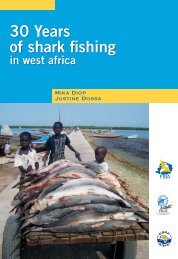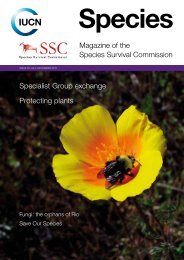Kyne & Simpfendorfer.. - Shark Specialist Group
Kyne & Simpfendorfer.. - Shark Specialist Group
Kyne & Simpfendorfer.. - Shark Specialist Group
You also want an ePaper? Increase the reach of your titles
YUMPU automatically turns print PDFs into web optimized ePapers that Google loves.
CASE STUDY 2. NORTHEAST ATLANTIC DEEPWATER FISHERIES<br />
Status: Stocks of the most commonly caught species, the leafscale gulper shark<br />
Centrophorus squamosus and the Portuguese dogfish Centroscymnus coelolepis, are<br />
depleted. Little data on other species, but some declines are also evident.<br />
The most common commercially-encountered deepwater sharks in the Northeast Atlantic are<br />
the leafscale gulper shark Centrophorus squamosus, birdbeak dogfish Deania calcea, black<br />
dogfish Centroscyllium fabricii, velvet belly Etmopterus spinax, great lanternshark E.<br />
princeps, Portuguese dogfish Centroscymnus coelolepis, longnose velvet dogfish<br />
Centroselachus crepidater, knifetooth dogfish Scymnodon ringens and the kitefin shark<br />
Dalatias licha (Basson et al. 2002, ICES 2005). Some scyliorhinid catsharks (Apristurus and<br />
Galeus spp) are also locally common, particularly the blackmouth catshark G. melastomus<br />
(Basson et al. 2002).<br />
Fisheries research in the Northeast Atlantic is coordinated through ICES (the International<br />
Council for the Exploration of the Sea) using data reported from a system of regional Sub<br />
areas. The majority of deepwater shark fishing activities occur in northern ICES Sub areas<br />
(Sub areas V, VI, VII, XII), particularly around the Rockall Trough and on the Porcupine<br />
Bank slopes, which lay to the west of the British Isles (Clarke et al. 2002). Species are taken<br />
in multi-species trawl and multi-species and directed longline fisheries. France, Iceland,<br />
Ireland, Norway, Portugal, Spain and the UK are the main countries in the region landing<br />
deepwater sharks (Walker et al. 2005). The most commonly landed species are C. squamosus<br />
and C. coelolepis, and it is these two species which are the primary focus of this case study.<br />
ICES (2006) presented limited landings data for other deepwater shark species in the<br />
Northeast Atlantic, however no CPUE data are available. It has only been since 1988 that C.<br />
squamosus and C. coelolepis have begun to be landed, initially by the French, then the<br />
Spanish and later by other nations (Heessen 2003, ICES 2006). The short time-period of the<br />
fisheries has generally limited assessments of trend data, until recently when ICES presented<br />
a series of CPUE trends for these species to advise that the stock had been depleted (ICES<br />
2005).<br />
Prior to the ICES advice, Basson et al. (2002) reported a declining trend for French trawl C.<br />
squamosus and C. coelolepis CPUE over a short time-series of 1990–1998 in ICES Sub areas<br />
VI and VII and Division Vb (the area to the West of the British Isles). They used production<br />
models to undertake biomass estimates, with results indicating that the exploitable biomass of<br />
these two species in those regions was below 50% virgin biomass. However, the short timeseries<br />
and the effects of fishing at different depths constrain their results. They also made the<br />
observation that the French trawl fleet was moving into deeper water to exploit sharks as well<br />
as other fish (Basson et al. 2002).<br />
As part of the European-wide DELASS project (Development of Elasmobranch Assessments)<br />
(Heessen 2003) stock assessments were attempted for these two species for the Northeast<br />
Atlantic as a whole. Although Heessen (2003) reports evidence of a decline in abundance<br />
(from CPUE data) for the two species combined in ICES Sub areas V, VI and VII, the stock<br />
assessment was unsuccessful due to a short time-series, a lack of species-specific data and a<br />
poor understanding of the stock structure of the species in the region.<br />
In 2005, ICES advised a zero catch limit for C. squamosus and C. coelolepis in ICES areas<br />
(i.e. the Northeast Atlantic) (ICES 2005). ICES (2005) noted that exploitation increased<br />
significantly from the commencement of fishing at the end of the 1980s while CPUE declined<br />
considerably for French, Irish, Norwegian, Portuguese and Scottish trawlers and longliners<br />
from 1994 to 2005 in the northern region (ICES Sub areas VI, VII and XII). Longline CPUE<br />
130
















